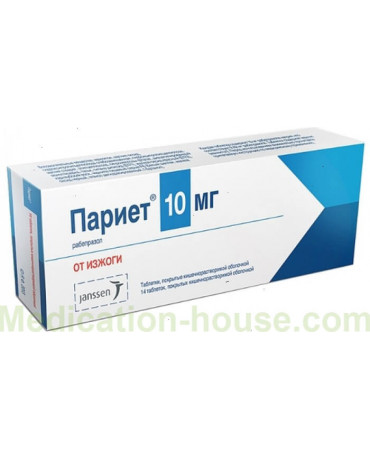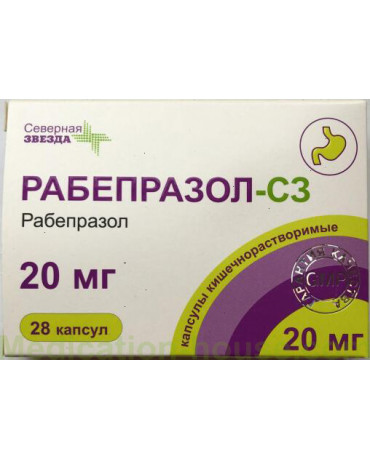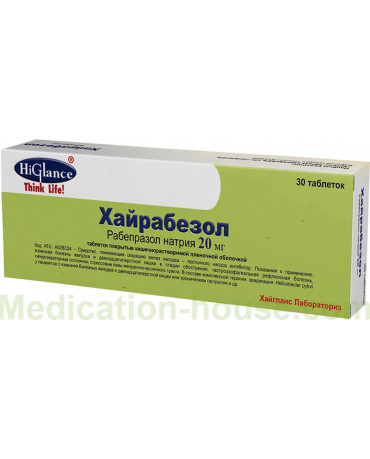Razo user manual
Reed more and buy Razo here
The proton pump inhibitor is Razo's medicine. Instructions for use report that 10 mg and 20 mg tablets help with gastritis, gastric ulcer and duodenal ulcer, including Helicobacter pylori in adults, children and during pregnancy.
Composition and form of release
Razo tablets are enteric coated with a pink to brownish-pink color, round, biconvex, with a black RB10 marking on one side; in cross section, the nucleus is almost white. 1 tablet contains 10 mg or 20 mg of rabeprazole sodium. Implement in blisters or a plastic can of 15 or 30 tablets. Packed in a cardboard box.
What helps the drug?
Tablets are prescribed for a wide range of conditions. Here are the main ones:
pancreatic adenoma;
gastric and duodenal ulcer;
reflux esophagitis;
Helicobacterpylori eradication in combination with antibiotics;
functional dyspepsia;
chronic gastritis and gastroduodenitis with high acidity in case of exacerbation.
Instructions for use
Razo is taken orally. The tablets must be swallowed whole, without chewing and grinding. Factors such as time of day and food intake do not have a significant effect on rabeprazole activity.
The standard dosage of the drug for various indications for adults: Anastomotic ulcer, peptic ulcer exacerbation: once a day 10 or 20 milligrams. The duration of the course of therapy, as a rule, is 6 weeks, sometimes it increases to 3 months.
Reflux esophagitis: once a day 10 or 20 milligrams. The duration of the course of therapy, as a rule, is from 4 to 8 weeks, sometimes it increases to 3-4 months.
Duodenal disease at the acute stage: take 20 milligrams of the drug once a day (for some patients, a daily dose of 10 milligrams may be prescribed). The duration of the course of treatment is from 2 to 4 weeks, if necessary, an increase in the duration of the drug up to 8 weeks is allowed.
Gastroesophageal non-erosive reflux disease: 10 or 20 milligrams of the drug are taken once a day. After the symptoms disappear, as part of the course of preventive therapy for relapse, continue taking the drug at 10 milligrams per day. If after a month of taking Razo the patient has symptoms of the disease, then additional studies are required.
Zollinger-Ellison syndrome or other conditions accompanied by pathological hypersecretion: an individual dosage is prescribed. At the beginning of the course of treatment, as a rule, a single dose of 60 milligrams per day is prescribed, then the dose is usually increased, taking either 60 milligrams twice a day (if fractional dosing is more preferable), or the drug is usually taken in single doses of 100 milligrams per day. The duration of admission is determined by the individual clinical picture, the duration of the course can last up to 1 year.
Helicobacter pylori eradication: take 20 milligrams of the drug twice a day as part of a 7-day course of anti-Helicobacter pylori therapy (the doctor determines the dosage schedule). GERD - gastroesophageal erosive reflux disease: take once a day 10 or 20 milligrams of Razo within the course of 4-8 weeks, sometimes the course of treatment is increased to 3-4 months; maintenance therapy - a single dose of Razo 10 or 20 milligrams per day, the duration of therapy is determined by the attending physician.
Pharmacological effects
Razo is an antiulcer drug of the proton pump inhibitor group. The mechanism of the therapeutic effect of the drug is to inhibit the activity of the enzyme H ± K ± ATPase in parietal gastric cells. This leads to blocking the final stage of hydrochloric acid production.
The pharmacological effect of Razo is dose-dependent and, regardless of the origin of the stimulus, suppresses not only basal, but also stimulated production of hydrochloric acid.
After rapid absorption from the gastrointestinal tract, the active component of the drug Razo reaches its maximum plasma concentration after 3-4 hours. Bioavailability is 52%. The ability to create bonds with plasma proteins averages 97%. Subjected to the "first pass."
It is metabolized by the hepatic isoenzymes of the CYP system. The half-life is 1 hour. The drug is excreted mainly in the urine.
Contraindications
period of breastfeeding (lactation);
children under 12 years old;
hypersensitivity to rabeprazole, substituted benzimidazoles or to auxiliary components of the drug;
pregnancy.
Side effects
From the digestive system: diarrhea, nausea, abdominal pain, vomiting, flatulence, constipation; rarely - dry mouth, dyspepsia, belching; in isolated cases - anorexia, gastritis, stomatitis, increased activity of hepatic transaminases.
From the side of the central nervous system and peripheral nervous system: headache, asthenia, dizziness, insomnia; rarely - nervousness, drowsiness; in isolated cases - depression, visual impairment and taste sensations.
From the respiratory system: possible - rhinitis, pharyngitis, cough; rarely - sinusitis, bronchitis.
Allergic reactions: rarely - skin rash; in isolated cases - itching.
Other: back pain, flu-like syndrome; rarely - myalgia, chest pain, chills, spasms of the calf muscles, urinary tract infection, arthralgia, fever; in isolated cases - an increase in body weight, increased sweating, leukocytosis.
Drug interaction
The simultaneous administration of Razo with digoxin is accompanied by an increase in the content of digoxin in plasma. Concomitant use of the drug with ketoconazole is accompanied by a decrease in the bioavailability of ketoconazole. Razo is undesirable to take along with alcohol, since this can have a significant impact on the effectiveness of therapy, as well as cause an increase in liver enzymes.
Special conditions
Improving the patient's condition during therapy with Razo does not exclude the presence of malignant neoplasms in the stomach. Moreover, the drug can mask the symptoms, which is why timely diagnosis is impossible. In this regard, before and after treatment, an endoscopic examination is necessarily indicated.
In observational studies, it was found that during therapy with proton pump inhibitors, the risk of fractures of the wrist, hip and spine in patients with osteoporosis increases. A higher probability of fractures in people receiving these drugs in high doses for a long time (from 1 year).
Influence on the ability to drive vehicles and complex mechanisms
Based on the data on the pharmacodynamics and the profile of side effects of rabeprazole, the possibility of a negative effect of Razo on the reaction rate and attention seems extremely low. However, patients whose drug causes dizziness and / or drowsiness should be discarded for the duration of treatment from driving vehicles and working with complex mechanisms.
Terms of sell
You don't need a prescription to buy Razo.






